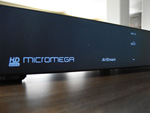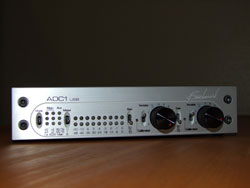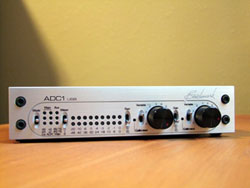Introduction
The pro-audio company Benchmark has a firm foothold in the audiophile world with their digital to analog converter/headphone amp the DAC1 and DAC1 USB. These have been universally well reviewed, especially here, and I’ve been able to listen to them myself, and I concur with the positive reports.
But a DAC is for when you already have some bits to ‘C’. What if you are a vinyl nut like myself? I buy most of my music on vinyl which is far far superior to CD sound but I can’t play vinyl in my car and even I have a little music server action going through my Squeezebox Duet (for the times when I can’t be stopping what I’m doing to flip records).
Specifications
- Design: 2 Channel Analog to Digital Converter
- Inputs: Two XLR Balanced
- Outputs: Five Digital outputs (1 XLR, 2 Coax, 1 Optical, 1 USB)
- Sample Rates: 44.1, 48, 88.2, 96, 176.4, and 192 kHz
- Output formats: AES/EBU, ADAT, and ADAT S/MUX2, and ADAT S/MUX4
- THD+N: -104 dB, 0.00063% @ -3 dBFS input, SNR 121 dB A-weighted
- Simultaneous Output at Two Different Sample Rates
- Simultaneous 16 and 24-bit Outputs
- Dimensions: 1.7″ H x 9.5″ W x 9.3″ D
- Weight: 3.6 Pounds
- Price: $1795 USA
- Benchmark Media
Well actually things are looking better and better for us vinyl nuts. Besides the fact that new music is more consistently released on vinyl, often on the same day as the CD (adding years to my life), nowadays many vinyl releases include a coupon for a download of a digital copy of the album. Usually in MP3 but at a high enough bit rate so as to not be completely annoying. Sometimes the record company just throws a CD inside the sleeve. My last trip to the record store was on ‘Vinyl Day’. I bought 5 records, 3 of which had coupons for MP3 downloads. Since it was ‘Vinyl Day’ I thought I might be getting some sort of discount. Yeah right.
For the other 40% of my recent vinyl purchases, not to mention all my old vinyl I need ADC – analog to digital conversion. If you’ve been slavishly reading my equipment reviews (I know I have), you know that I have ADC through my computer. Specifically a CardDeluxe high end sound card that does a good job at this. However, it wasn’t until recently that I solved a key dilemma in this arena, that of properly setting the recording levels. Chances are the levels out of a phono stage will not drive the inputs to any ADC to their full range. If they do, they might occasionally exceed that range and then you really have a problem. I’ve written some before about this in my review of the PS Audio GCPH.
The short of it is that the GCPH at long last gave me the ability to adjust the record levels in the analog realm, ensuring that I utilized the full range of available bits in the digital realm.
So, how could vinyl recording get any better? Well there is always the possibility of higher quality. And then there is the matter of where the computer is. The CardDeluxe is a full size PCI card for a desktop computer. A computer with fans, a keyboard and monitor. For me, this must be in a different room than my main system, the one with the best turntable.
The Benchmark ADC1 has no fans, though it probably needs good ventilation as it gets plenty warm. It has a USB output which plugged into my laptop and started working with no further computer settings or adjustments. Oh, and it has (analog realm) adjustable gain, per channel no less.
There’s a lot I could say about the user interface of the ADC1 but I’ll save that for the end because I’ve been going on a long time here just to set the stage. I made some recordings with the ADC1, how did they sound?
In Use – Some Recordings
I started with the ADC1 in my second system so that I could compare it to the CardDeluxe directly…
Spritualized: Songs in A&E
I recorded side one of this record once with the Carddeluxe and once through the ADC1. Actually it was twice through the ADC1, the first recording suffered from some dropouts. This could be because I was doing too many other things on my computer at the same time (web, email) or it could be that I had also opened MS Word to start working on this article. When in doubt, blame Microsoft. I used the PS Audio GCPH so I could get proper levels for both the Carddeluxe and the ADC1. I used FastEdit for both recording and editing. The recording was made at 44.1kHz to avoid any issues with conversion for CD. ‘Editing’ consisted of breaking up the recording into individual songs. I then burned these songs to CD, alternating the track recording with the Carddeluxe with the same track as captured by the ADC1.
When I first started to play the CD through my main system (Naim CDS2 CD player) my first thought was, ‘oh, too bad I won’t be able to say the ADC1 is better than the Carddeluxe’, the sound seemed as sublime as the record. The first track is ‘Harmony 1 (mellotron)’. The sound as recorded by the Carddeluxe was sweet and transcendent. A new-age spacey intro to this great album. I quickly switched up to the ADC1 version and I thought ‘oh…’. Wait, I hear a background line from a synth – was that even there with the Carddeluxe version?? I switched back – yes it was there but it didn’t stand out. The same thing happened on track after track. I kept having to switch back – were those drums (drums!) even there? Yes but not so you’d notice. ‘Those background vocals – when did they start? I guess they did a fade up..’ switch to ADC1 ‘Nope, no fade up, they start at the same time as the lead vocal but it was indistinct before’. This is what I call audiophile sound – the parts, the instruments, the voices are each a separate entity. A stereo can sound pretty good without this and it’s pretty hard to figure out that it’s not happening until you hear it. One way to figure it out is to see how long you feel like listening. Consistently, with the Carddeluxe tracks I wanted to move on, with the ADC1 tracks I wanted to listen to the end.
I went through the same exercise with Erykah Badu’s New Amerykah, Pt. 1: 4th World War. Same result as with the Spritualized. Of course at this point I had trained myself for what to listen for and the differences were subtle. But with the Benchmark the backgrounds were deeper, blacker and the voices, instruments all had more space around them. As before, I wanted to listen to the end of the Benchmark tracks. I think Ms Badu is a genius BTW.
Why should the ADC1 be better than my dedicated sound card? That card has to operate inside a computer. If you don’t know how much noise is coming off a computer mother board, tune an AM radio to your favorite station and move it close to a laptop. The truly amazing news is that something as delicate as analog to digital conversion can happen at all in that environment. In addition, the Benchmark literature makes a point of their proprietary solutions to the problem of jitter. All of digital audio theory is predicated on the idea that the clock, the samples, occur at regular intervals. Any deviation from this on the recording or playback end results in noise. And this is not your father’s noise. The cumulative effect of these digital ‘mistakes’ is not part of any harmonic, rather it is smearing and listener fatigue. I’ll climb down off my soapbox now. Regarding this comparison I also have to note that the ADC1 costs about 4 times as much as the CardDeluxe, of course there is a lot more to the ADC1, the box, the display, the controls, more connection options etc all of which are part of the price.
So that was my experience with CD quality sound. I think we’ve all had just about enough of that. For higher resolution I set the ADC1 to 24bit 88.2kHz (the idea being I could create 44.1 tracks for CD with minimal processing but that is a topic for another day). For playback I have a gorgeous old Bel Canto DAC1, a beautiful little box to be sure but alas no USB input. To convert the USB output from my laptop to S/PDIF I borrowed a Trends Audio UD-10.1 USB Audio Converter from my good friends at Stereotypes Audio in Portland, OR. Another happy plug and play experience. I’d like to say more about Trends Audio USB converter but other than ‘it worked right away and caused no problems’ I wouldn’t know what to say. It’s highly unlikely that any such device would drop bits or anything like that. It could of course introduce jitter that would affect the downstream DAC but I didn’t have anything on hand to compare or measure it with. The Trends box worked without a hitch and looked good doing it.
Time was running short for this review (I spent a lot of time messing around with different recording software for no good reason) so I made just one hi res comparison. I recorded Sonic Youth’s new album ‘The Eternal’ at 24/88.2 and compared it to the accompanying MP3 download. Hardly a fair comparison but that is what we are facing with these downloads. We buy the vinyl because it is superior. The MP3 downloads might provide some convenience but they certainly don’t reproduce the experience of listening to vinyl. In this case the Matador record’s MP3’s were recorded at a variable rate. Winamp kept flashing 256 and 320 Mb/s. It also indicated that the sample rate was 44.1. My Bel Canto DAC upsamples 44.1 to 88.2. As near as I can tell, when fed 88.2 it doesn’t upsample.
So does the 88.2kHz recording through the Benchmark ADC1 replicate the vinyl experience? It gets pretty close. Perhaps close enough. I have no qualms about an extended listening session with this recording. The vinyl is still a tad better, a little more presence in the room. More gravity if I may introduce a new audiophile term (oh boy we really need that). Vinyl playback makes it feel like the music is in the room. An object to itself. But other than this difference in feeling it’s hard to distinguish the Vinyl from the 88.2. The MP3 for it’s part actually held up pretty well – if sparkle is your thing. Like any Sonic Youth record this one has its share of treble from Thurston Moore’s guitar(s) and the MP3 had its way of emphasizing that. But the soundstage was thin, with an ‘in your face’ quality. Texture on the bass notes was lost and then there was that fatigue thing.
I made another high res recording, this time from a Cat Power EP I found on vinyl: Dark End of the Street. (This also from Matador Records but no MP3 download – what’s up with that??). This is a much more sparse record, mostly piano and voice rather than the guitar on top of guitar that Sonic Youth favors. The ADC1 seemed to really have its way with it. The recording is as sublime and enchanting as the vinyl. In this case it really seems a tossup as to which is better. The vinyl is maybe a little better in the voice, maybe. The 88.2 recording better in the bass. Maybe that’s because I kept the volume down while making the recording, no feedback getting from the speakers to the needle. One other things tilts towards the ADC1’s favor, this EP is a double 10″ issue, one to three songs per side, if you think getting up to flip sides every 20 minutes is bad..
The Sonic Youth recording was made with the free software Audacity while the Cat Power recording was made with a trial copy of Sony’s Sound Forge (trial period long since expired). I’d like to think that since I made no edits or transformations to the recorded audio the software was not a factor.
Usability
At first glance the user interface of the ADC1 is a little intimidating. Get over it, it’s actually quite easy. I had an early version of the user manual which led one to believe that the arrays of LED’s and switches were used to set the sample rate for the recording. Actually they only set output rates. The ADC1 has two S/PDIF digital outputs (for monitoring or what have you). The USB output, from whence the recoding is made has its sample rate set by the computer and your recording software. So for my purposes I never had to worry about any of the controls except the analog gain. I messed with them anyway and I have to say that all the controls feel as though they were made to last. The knobs to control the analog gain feel very solid and have 41 détente’s (you know, positions they click into) so that you can feel assured that you have the two channels set to the same gain. One thing I would add is an on/off switch. As I said the ADC1 gets plenty warm and I don’t need to see the level meters operating when I’m not using it. Another nifty enhancement would be to have the USB function in the other direction so that I could play my recordings back and use the digital outs from the ADC1 during playback.
Conclusion
I loved what the ADC1 did for my vinyl recordings. At this point I don’t want to be without it so I will look into buying this review sample (I’ve been upgrading my systems a lot lately so its getting kind of painful pocketbook wise). This little gem provides grain free, fatigue free recordings that I crave. There are other computer sound card solutions, at prices comparable to the ADC1 that I haven’t tried so this is by no means a comprehensive review of the options available but, the ADC1 is portable, it looks great in either my main system or I can take it upstairs to my regular vinyl recording system next to the computer. A better soundcard would fit only the latter option. With the ADC1 I know that I will get a recording that I really want to hear, not something (MP3) that I have to endure. Recommended for vinyl nuts who want their bits as well.





